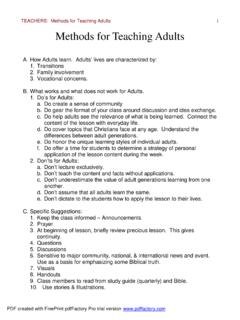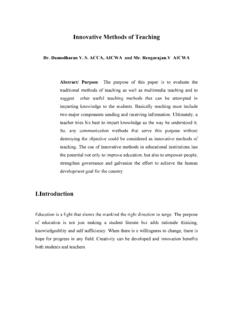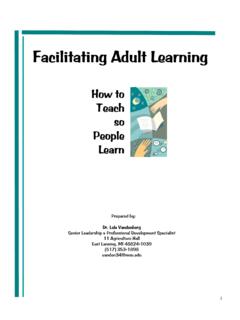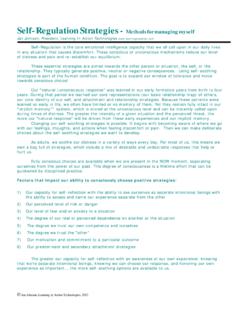Transcription of Interactive Techniques - fctl.ucf.edu
1 Interactive Techniques Adapted in part from: Thomas A. Angelo/K. Patricia Cross, Classroom Assessment Techniques . 2nd Edition. Jossey-Bass: San Francisco, 1993. Alison Morrison-Shetlar/Mary Marwitz, teaching Creatively: Ideas in Action. Outernet: Eden Prairie, 2001. Silberman, Mel. Active Learning: 101 Strategies to Teach Any Subject. Allyn and Bacon: Boston, 1996. VanGundy, Arthur. 101 Activities for teaching Creativity and Problem Solving. Pfeiffer: San Francisco, 2005. Watkins, Ryan. 75 e-Learning Activities: Making Online Learning Interactive .
2 San Francisco: Pfeiffer, 2005. These Techniques have multiple benefits: the instructor can easily and quickly assess if students have really mastered the material (and plan to dedicate more time to it, if necessary), and the process of measuring student understanding in many cases is also practice for the material often students do not actually learn the material until asked to make use of it in assessments such as these. Finally, the very nature of these assessments drives interactivity and brings several benefits.
3 Students are revived from their passivity of merely listening to a lecture and instead become attentive and engaged, two prerequisites for effective learning. These Techniques are often perceived as fun , yet they are frequently more effective than lectures at enabling student learning. Not all Techniques listed here will have universal appeal, with factors such as your teaching style and personality influencing which choices may be right for you. Instructor Action: Lecture 1. Picture Prompt Show students an image with no explanation, and ask them to identify/explain it, and justify their answers.
4 Or ask students to write about it using terms from lecture, or to name the processes and concepts shown. Also works well as group activity. Do not give the answer until they have explored all options first. 2. Think Break Ask a rhetorical question, and then allow 20 seconds for students to think about the problem before you go on to explain. This technique encourages students to take part in the problem-solving process even when discussion isn't feasible. Having students write something down (while you write an answer also) helps assure that they will in fact work on the problem.
5 3. Choral Response Ask a one-word answer to the class at large; volume of answer will suggest degree of comprehension. Very useful to drill new vocabulary words into students. 4. Instructor Storytelling Instructor illustrates a concept, idea, or principle with a real-life application, model, or case-study. 5. Pass the Pointer Place a complex, intricate, or detailed image on the screen and ask for volunteers to temporarily borrow the laser pointer to identify key features or ask questions about items they don t understand.
6 6. Empty Outlines Distribute a partially completed outline of today s lecture and ask students to fill it in. Useful at start or at end of class. 7. Classroom Opinion Polls Informal hand-raising suffices to test the waters before a controversial subject. 8. Total Physical Response (TPR) Students either stand or sit to indicate their binary answers, such as True/False, to the instructor s questions. 9. Hand Held Response Cards Distribute (or ask students to create) standardized cards that can be held aloft as visual responses to instructor questions.
7 Example: green card for true, red for false. Or hand-write a giant letter on each card to use in multiple choice questions. 10. Student Polling Select some students to travel the room, polling the others on a topic relevant to the course, then report back the results for everyone. 11. Self-Assessment of Ways of Learning Prepare a questionnaire for students that probes what kind of learning style they use, so the course can match visual/aural/tactile learning styles. 12. Quote Minus One Provide a quote relevant to your topic but leave out a crucial word and ask students to guess what it might be: I cannot forecast to you the action of _____; it is a riddle, wrapped in a mystery, inside an enigma.
8 This engages them quickly in a topic and makes them feel invested. 13. Everyday Ethical Dilemmas Present an abbreviated case study with an ethical dilemma related to the discipline being studied. 14. Polar Opposites Ask the class to examine two written-out versions of a theory (or corollary, law of nature, etc.), where one is incorrect, such as the opposite or a negation of the other. In deciding which is correct, students will have to examine the problem from all angles. 15. Pop Culture Infuse your lectures, case studies, sample word problems for use during class with current events from the pop culture world.
9 Rather than citing statistics for housing construction, for instance, illustrate the same statistical concept you are teaching by inventing statistics about something students gossip about, like how often a certain pop star appears in public without make-up. 16. Make Them Guess Introduce a new subject by asking an intriguing question, something that few will know the answer to (but should interest all of them). Accept blind guessing for a while before giving the answer to build curiosity. 17. Make It Personal Design class activities (or even essays) to address the real lives of the individual students.
10 Instead of asking for reflections on Down s Syndrome, ask for personal stories of neurological problems by a family member or anyone they have ever met. 18. Read Aloud Choose a small text (500 words or less) to read aloud, and ask students to pay particular attention during this phase of lecture. A small text read orally in a larger lecture can focus attention. 19. Punctuated Lectures Ask student to perform five steps: listen, stop, reflect, write, give feedback. Students become self-monitoring listeners. 20.









